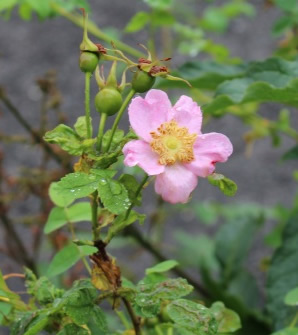Prickly Rose

Botanical Name: Rosa acicularis
Common Name: Wild Rose
Other Names: Shnipiishnik (from the Russian word snipisnik ‘rose’)
Found in: Throughout Alaska, except for the extreme north Arctic, from thickets, woods, and moist meadows to bogs
Physical Characteristics: A very prickly shrub, 1-6 feet tall and generally with toothed 5 part compound leaves with distinct stipules. The large, showy flowers (2-3 inches) have 5 rounded pink, soft, velvet-like petals that are sometimes notched. Twigs are very red in the winter and the leaves turn reddish in the fall (Pratt 1989)
Nutritional Value: Vitamins A, B, C, E and K, also the minerals calcium, iron, silica and phosphorous.
Parts of the plant used: petals and hips
When plant should be gathered: Gather petals in July or sooner if the flowers have formed. Rose hips are collected in September and October.
Plant applications: Tea, food.
Reported Benefits: flavoring tea and other foods
Preparation/Processing: Tea/flavoring: People gather rose petals in July or sooner if the flowers have formed. After drying them, they mix the petals with tea to flavor it.
People collect rose hips in the fall to add them to pies and other deserts.
Like the rose petals, rose hips are also edible, and many people dry them for tea and enjoy the flavor as well as the extra Vitamin C. Rose hips can also be eaten raw, although it’s a lot more palatable to slice them open and remove the numerous seeds inside of them first.
Rose petals are also medicinal, in that they are topically bacteriostatic, meaning they inhibit bacteria from multiplying. Out in the field, if you got a cut or a wound of some kind, rose petals could be used as a nice wilderness bandage to prevent infection.
